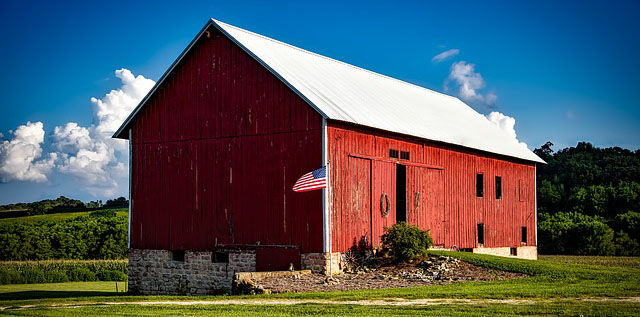
The American Barn
When the pioneers settled the wild American frontier, the land was a blank canvas, ready to be settled and farmed. But to establish successful farms, farmers needed a place to house their livestock and store their feed and flourishing crops.
Out of this necessity, the American Barn was born. The barn was so important to farmers that their construction took precedence over the construction of farmhouses. Building the barns was a community tradition called “barn raising” during which every abled person would lend their neighbors a helping hand. American barns dotted the countryside from the states of New England to the prairies in the West, but no barn was exactly alike.
In the Midwest, farmers often built Bank Barns similar to the one above into the sides of hills. Bank Barns had two levels - a bottom level to house livestock and a top level for crop and hay storage. The second level often was larger than the first, creating a protective overhang for the livestock.
Found less often than Bank Barns and other barns, Round Barns were a structural choice in the Midwest and New England regions. From its name, you can probably guess the layout of this barn was circular. Round Barns were more frequently built in the late 1800’s because agricultural colleges emphasized resourceful farming techniques, and they believed Round Barns were more efficient than rectangular barns.
Southern farmers constructed Crib Barns, especially in mountainous regions. Crib Barns held several compartments and sometimes had a second level or a large breezeway. In the Southeast, Tobacco Barns were often built. They were used to store and dry out tobacco, a process that stained the barn wood. These stains and other beautiful characteristics can be found in Reclaimed Antique Tobacco Pine Wide Plank Flooring.
While the farmers in the Southeast built Crib Barns and Tobacco Barns, their brothers in the Southwest and West built Prairie Barns. Also known as Western Barns, farmers used them to house massive herds of livestock and enough hay for feed. Prairie Barns were much larger than other barn types for these reasons and had very low rooflines to increase the amount of storage for feed.
Although these are some very popular barn types, the American Barn comes in all shapes and sizes. These beautiful structures are being dismantled because of changes to the agricultural industry, but their timber receives a second chance at life by becoming barn siding for wall treatments and ceilings or reclaimed wood flooring. The timber for this product has been around for centuries and will be around for more to come.